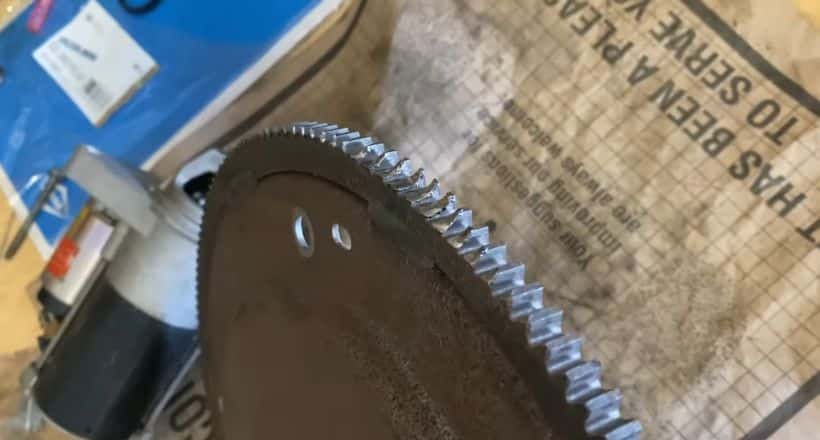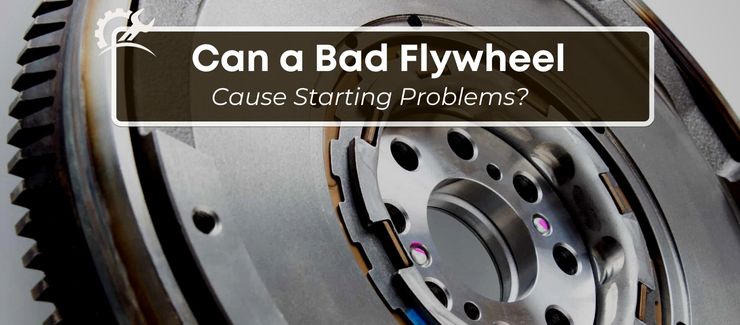Answer:
A damaged flywheel may not be able to engage with the starter motor properly. This can cause the flywheel (and the crankshaft) to not rotate like normal, resulting in the engine starting with difficulty or not starting at all.
A flywheel is a heavy, large-sized disc attached to the crankshaft and is one of the many components that enable your vehicle to start.
When you turn on the ignition, the starter motor engages with the flywheel’s teeth and causes it to rotate and start the engine.
Apart from that, it also stores the rotational energy when the engine is speeding up (power stroke) and imparts it when the engine is slowing down (intake, compression, and exhaust strokes).
In this way, the flywheel allows the engine to rotate at a relatively consistent speed, resulting in smooth power delivery. The engine’s rotational speed will fluctuate wildly without a flywheel (depending on its strokes), causing it to stall – especially in low-speed operations.
Lastly, the flywheel is responsible for allowing the clutch to engage and disengage the engine’s power from the transmission in vehicles with manual transmission.
Can a Bad Flywheel Cause Starting Problems?
There are two scenarios where a bad flywheel can cause starting issues in your vehicle.
The first one is the worn/broken teeth on the flywheel. They cause the starter motor not to engage properly, resulting in the engine turning on with difficulty or not turning at all.
The other issue is the unbalanced flywheel that can cause uneven wear on the starter ring gear. This uneven wear can affect the flywheel’s engagement with the starter motor and damage other engine parts.
Symptoms of a Bad Flywheel
Apart from the inconsistent (or no) starting, many other signs indicate a bad flywheel, such as:
Noise From Transmission at Idle
If your vehicle has a double-mass flywheel and you’re getting rattling or grinding noises from the transmission while the engine is idling, it indicates the flywheel is not working properly.
Gear Slipping
A warped flywheel can result in gears not engaging properly, aka. Slipping. In such a situation, your engine RPMs go up, but the power doesn’t transfer to the wheels. Therefore, the vehicle speed remains the same.
If you’re experiencing gear slipping, you must fix it immediately, as it may damage other parts of your transmission system.
Difficulty In Shifting Gears
A bad flywheel can put uneven wear on the clutch disk. This uneven wear can affect the engagement and disengagement of the clutch, and you may find it difficult to change the gears smoothly.
Battery Drainage
In some rare cases, a bad flywheel can cause the starter motor to draw more power from the battery, resulting in drainage.
Burning Odor
A slipping flywheel can cause the clutch disk to overheat (due to friction), resulting in a burning smell from the engine compartment. In some cases, there can be visible smoke, too.
Vibrations
A cracked or loose flywheel can also cause excessive vibrations in your vehicle. These vibrations can be felt on the vehicle floor and intensify when accelerating or going uphill.
Conclusion
A flywheel plays a critical role in starting our vehicles. That’s why if you’re experiencing any of the abovementioned problems, you should get it checked by a mechanic.
If you’ve diagnosed a problem early, it can be fixed quickly and (relatively) cheaply.
On the other hand, not fixing the issue can aggravate the problem and may require flywheel replacement altogether.
How Do I Know if My Starter or Flywheel is Bad?

Since the flywheel relies on the starter motor for rotation, any issue with the latter can cause starting issues in your vehicle.
To verify whether it’s your starter motor or flywheel, you must check these parts individually.
A bad flywheel will be off-balance or have some of its teeth damaged/broken, causing it not to engage with the starter motor properly.
On the other hand, if the flywheel looks perfectly fine, the starter motor can be the possible culprit. But you shouldn’t make any assumptions before testing.
How Much Does it Cost to Repair or Replace a Flywheel?
The cost of repairing a flywheel will depend on the make/model of your vehicle, labor cost in your area, and the extent of the damage.
If the damage is minor (the flywheel teeth are worn out and require resurfacing), it can be solved for $100-$200.
On the other hand, if the damage is beyond repair (broken teeth), you may need to replace that flywheel with a new one – costing you more than 1000 bucks after including the labor cost.
How To Start an Automatic Transmission Car With a Bad Flywheel?
Automatic transmission cars come with a component called flexplate, which serves the same purpose as the flywheel in manual transmission vehicles.
If the flexplate has missing or worn-out teeth, it is possible to start the car by rotating it manually with the help of a ‘flywheel turner’ (such as this one). You only need to have access to the flexplate.
That said, you shouldn’t rely on this method and repair the flexplate as soon as possible. Otherwise, you might cause further damage to the transmission or flexplate itself.
On the other hand, you shouldn’t try to start the vehicle if the flexplate appears to be cracked, as it’s too risky for you and the vehicle.
Is it OK to Drive With a Bad Flywheel?
If only a few flywheel teeth are broken, you can start the vehicle after some attempts. But I still won’t recommend doing this, as you may have difficulty shifting gears, the car may vibrate (and damage other parts of the engine), or the engine may shut off randomly.
What are The Symptoms of an Unbalanced Flywheel?
The most common sign of an unbalanced flywheel is the vibration coming from the engine. These vibrations can be felt throughout your vehicle and increase as you turn up the RPMs.
How Often Should a Flywheel Be Replaced?
Under normal conditions, a flywheel should last 80,000-100,000 miles before replacement.
What Causes a Flywheel to Fail?
Some common causes for flywheel failure include engaging with the starter while the engine is running, improper maintenance, overheating, and rust/corrosion.
